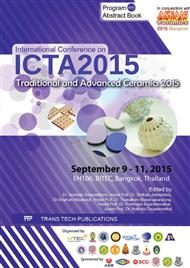[1]
J. Suwanprateeb, F. Thammarakcharoen, P. Phanphiriya, W. Chokevivat, W. Suvannapruk and B. Chernchujit, Preparation and characterizations of antibiotic impregnated microporous nano-hydroxyapatite for osteomyelitis treatment, Biomed. Eng. Appl. Basis Commun., 26 (2014).
DOI: 10.4015/s1016237214500410
Google Scholar
[2]
J. Suwanprateeb, W. Suvannapruk and K. Wasoontararat, Low temperature preparation of calcium phosphate structure via phosphorization of 3D-printed calcium sulfate hemihydrate based material, J. Mater. Sci. Mater. Med., 21 (2010) 419-429.
DOI: 10.1007/s10856-009-3883-1
Google Scholar
[3]
H. G. Watts and R. M. Lifeso, Current Concepts Review - Tuberculosis of Bones and Joints, J. Bone Joint Surg. Am., 78 (1996) 288 -299.
DOI: 10.2106/00004623-199602000-00019
Google Scholar
[4]
M. Zhu, H. Wang, J. Liu, H. He, X. Hua, Q. He, L. Zhang, X. Ye and J. Shi, A mesoporous silica nanoparticulate/b-TCP/BG composite drug delivery system for osteoarticular tuberculosis therapy, Biomaterials, 32 (2011) 1986-(1995).
DOI: 10.1016/j.biomaterials.2010.11.025
Google Scholar
[5]
H. Q. Zhang, Q. L. Gao, H. B. Guo, J. S. Li, C. F. Guo, S. J. Lu, S. Huang, Preparation and release in vitro and in vivo of isoniazid-chitosan sustained release microsphere-loaded human allogeneic bone, Chin. J. Tissue Eng. Res., 16 (2012).
Google Scholar
[6]
D. A. Ferreira, A. G. Ferreira, L. Vizzotto, A. F. Neto and A. G. de Oliveira, Analysis of the molecular association of rifampicin with hydroxypropyl-β-cyclodextrin, Braz. J. Pharm. Sci., 40 (2004) 43-51.
DOI: 10.1590/s1516-93322004000100008
Google Scholar
[7]
Y. Liu, P. Layrolle, J. de Bruijn, C. A. van Blitterswijk and K. de Groot, Biomimetic co-precipitation of calcium phosphate and bovine serum albumin on titanium-alloy, J. Biomed. Mater. Res., 57 (2001) 327-335.
DOI: 10.1002/1097-4636(20011205)57:3<327::aid-jbm1175>3.0.co;2-j
Google Scholar
[8]
R. J. Chung, Study of hydroxyapatite nano composites with photoluminescence properties, Biomed. Eng. Appl. Basis Commun., 23 (2011) 107-112.
DOI: 10.4015/s1016237211002451
Google Scholar
[9]
R. J. Chung, F. Peters, K. Schwarz and M. Epple, The structure of bone studied with synchrotron X-ray diffraction, X-ray absorption spectroscopy and thermal analysis, Thermochim. Acta, 361 (2000) 131-138.
DOI: 10.1016/s0040-6031(00)00554-2
Google Scholar
[10]
S. Koubaa, C. Burtin, S. L. Corre, Investigation of capillary impregnation for permeability prediction of fibrous reinforcements, 18th International Conference on Composite Materials, 21-26 Aug 2011, South Korea, 1-5.
DOI: 10.1177/0021998315593797
Google Scholar
[11]
F. Liu, H. Zhang, Q. Cao, X. Xiang, L. Wang, T. He, W. Liu, Y. Fang, D. Y. B. Deng and W. Zhou, High-efficiency loading in small mesopores (2–3 nm) forming a matrix type controlled drug delivery nanosystem, RSC Adv., 4 (2014) 8918-8921.
DOI: 10.1039/c3ra47035k
Google Scholar
[12]
B. J. Deadman, C. Battilocchio, E. Sliwinski and S. V. Ley, A prototype device for evaporation in batch and flow chemical processes, Green. Chem., 15 (2013) 15, 2050–(2055).
DOI: 10.1039/c3gc40967h
Google Scholar


